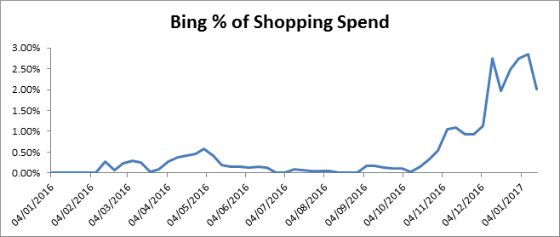Google Vehicle Ads: The Digital Master Key for the Motor Industry
Advertising via Google is constantly evolving, and new ways to showcase your brand and business offering are regularly being rolled out. The latest...
Read morePaid search specialist Ian Boyden takes a look back at what was new in 2016 and what to expect in 2017 as he details five paid search tactics ecommerce companies should consider pushing in the year ahead.
2016 was a year of big change in the world of paid search. First, right hand side ads were removed and advertisers found themselves jostling for a fourth ad position. Then there were changes to the ads themselves. Google made Global Trade Item Numbers (GTINs) obligatory in May, while testing began on expanded text ads (ETAs) in June. September then saw tablet bidding return to AdWords, as Google split up its device bidding options.
But of course, the paid search industry never stands still. 2017 looks set to see more big developments. Read on to discover the five factors to keep in mind when finalising your paid search budget for 2017.

While Local Inventory Ads are not necessarily new (they’ve been around for a while, but truly broke through in 2016), this year is likely to see a much bigger uptake of this product by ecommerce retailers.
Designed to promote your in-store inventory and provide a link between your online presence and your bricks and mortar stores, Local Inventory Ads are currently available in the US, UK, Germany, France, Japan and Australia.
Some of our ecommerce clients have allocated as much as 20% of their paid search budget to this channel, with ROAS outperforming traditional shopping ads, showing its power at driving in-store conversions.
The vast majority of spend for Local Inventory Ads come through mobile, in line with the increasing consumer preference for mobile devices.
In order to reap the rewards, some work is required by the retailer. Inventory feeds for each store are needed, and while this can be challenging, the results are worth it.

Back in July 2016, Google started rolling out updates to Shopping, namely Showcase Shopping Ads – a fresh take on PLA formats for broad match product keywords.
This meant a brand new look for product listings on non-brand, broad queries, whereby three product images are presented to users along with a promotional message as opposed to the standard view of one product image per brand.
The main drawback with Google Shopping in its original state is deciding which product should be shown for “broad” searches. Sending a new user to a specific product page without them seeing the rest of the product range may not result in the best possible conversion rates on broad match.
By the very definition of broad match terms, it makes perfect sense for users to be presented with choice, and although it’s still in its early stages, Showcase Shopping Ads has the potential to reform Shopping if applied with gusto in 2017.
And with Google classing 40% of searches as “broad” this product could transform Shopping performance for ecommerce retailers looking to extend their reach, by becoming more competitive in the broad match landscape.
Given the instant success and quick growth of Google Shopping, it has been surprising to see Bing Shopping grow at a much slower rate.
As of Q4 2016, it still represents less than 1% total Shopping spend, however in recent months we have seen indicators that traffic is picking up.

As Google Shopping and improved PLA formats are beginning to monopolise prime SERP real estate, it follows that advertisers should prepare for the gradual growth of Bing Shopping.
Even though it is moving at a slower rate than that of Google Shopping, early trends point to the cumulative importance of Shopping across both ad providers. After all, a solid Shopping strategy that slowly incorporates Bing essentially means blanket coverage for your brand.
Comparatively on text ads, we are seeing Bing spend around 15% of the text ads budget, so if Bing Shopping can replicate the success of text ads across its Shopping format, there could be a great opportunity to drive incremental sales through this channel.
One to keep an eye on in 2017.

A lot of time and resource was invested in Expanded Text Ads by advertisers in 2016. ETAs in a nutshell? The introduction of the expanded text ad in 2016 gave advertisers more room to create more compelling ads, in turn improving engagement levels and CTR.
On the whole, those who migrated to ETAs in the first instance saw CTR benefits. However in 2017, all advertisers will be on ETAs so this is the time to get ahead of the competition and invest time in testing new ad copy.
How do you make sure you’re getting the most out of your ETAs? If you haven’t already been doing so, now is the time to start testing.
This is your opportunity to refocus your AdWords efforts. That’s not to say that you should completely neglect your standard text ads – you’ve spent considerable time refining them, so use ETAs to enhance what you already have with the additional space provided.
Don’t forget to test the myriad of new ad extensions being launched, and add these elements to your testing as well – with additional time spent refining ETAs now, your revenue figures come Q4 2017 should be in a much healthier position.
Testing ad variations will mean more investment time, but the good news is that having the extra characters and headline available has made ad testing easier than ever – here at ClickThrough we have been testing new ideas to boost CTR, and will continue to do so on a larger scale in 2017.

Mobile searches have been higher than desktop and tablet for some time now – even more so in Q4 2016 with Black Friday and Christmas driving significant amounts of transactions on mobile. Substantial search volume opportunity, cheaper CPCs, better CTR and improving conversion rates mean we can truly say that mobile is the key device.
More importantly, we are starting to see mobile ROAS outperform that of desktop and tablet, even without cross-device and in-store conversions factored in.
With mobile now front and centre, so too is the need to factor a solid mobile strategy into your 2017 plans. Harnessing AdWords ad extensions (sitelinks, location, call data) will help you to carve out clear conversion paths for your demographic, while device level bidding will help you control the search queries and products categories on your site that drive the most revenue and the best ROAS via mobile.
With device level bidding, we now have more levers to ensure that bids are strategically set to drive the best ROAS for your brand. It is more important than ever to closely monitor your device performance to make sure that you are not over inflating your desktop/tablet bids at the expense of mobile.
Don’t Forget The Basics
Ecommerce paid search is growing, while also getting more complex each year – and 2017 will be no different.
There will inevitably be countless new BETAs and products to test and more levers to optimise, but it is easy to forget the basics that truly drive your results.
Here at ClickThrough, we will be continuing to make sure that the vast majority of time is being invested in areas which drive efficiency and incremental sales. Keyword and negative expansion, regular account audits and housekeeping, ad testing and landing page improvements are many of the areas where we believe a significant amount of time should be spent to get ahead of the competition.
The devil is in the detail!
We have also been investing in our team, ensuring that each paid search team member is up to speed when it comes to running AdWords accounts according to Google’s best practice guidelines. Now recognised as Premier Google Partners, we continue to work towards adding value to our client accounts with improved strategic approaches that keep up with industry updates.
Finally, innovation is key in being able to analyse and optimise successfully, especially now there is even more data available to us. We are making our optimisation techniques smarter this year in order to deal with the search landscape becoming more competitive in 2017, and will continue to support our clients with more efficient optimisation techniques to drive effectual campaigns that remain one step ahead of the rest.
Looking for support with a growth-focused ecommerce strategy? Or require more detailed forceasting to factor in fresh tactics for 2017? Download our expert guide on building a strategic forecast to boost ecommerce sales.
More articles you might be interested in:
.png)
Advertising via Google is constantly evolving, and new ways to showcase your brand and business offering are regularly being rolled out. The latest...
Read more.png)
The UK market has been waiting with bated breath for Google’s Vehicle Ads release – so where is the update? Learn more.
Read more.jpg)
Performance Max is one of the easiest ways to tackle the full Google network, but are you maximising results? Dr. Dave Chaffey explores. Read more.
Read more
Welcome to the latest round-up of all things digital. This is where we look at the latest updates in the world of PPC, SEO, Content and International...
Read more.jpg)
Creating conversion-optimised PPC campaigns start at strategy planning. Do you know how you can maximise the return on your ad investment? Dave...
Read more
We're heading into a new financial year - do you know how PPC can help grow your conversions? Find out how developments from Google and Bing will...
Read more
What are the benefits of Google's new Performance Max campaign type? Head of DPM, Sarah Clarke, tells us how you can use it to automate your...
Read more
It may have seemed like just your average PPC role at first, but what Alex Copping didn't realise is that he was about to learn a whole lot about...
Read more